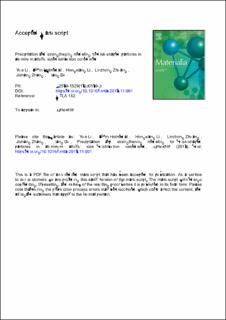| dc.contributor.author | Li, Yue | |
| dc.contributor.author | Holmedal, Bjørn | |
| dc.contributor.author | Li, Hongxiang | |
| dc.contributor.author | Zhuang, Linzhong | |
| dc.contributor.author | Zhang, Jishan | |
| dc.contributor.author | Du, Qiang | |
| dc.date.accessioned | 2020-12-07T09:14:48Z | |
| dc.date.available | 2020-12-07T09:14:48Z | |
| dc.date.created | 2019-01-14T11:14:11Z | |
| dc.date.issued | 2018 | |
| dc.identifier.citation | Materialia. 2018, 4 431-443. | en_US |
| dc.identifier.issn | 2589-1529 | |
| dc.identifier.uri | https://hdl.handle.net/11250/2712101 | |
| dc.description.abstract | For an ICME (Integrated Computational Material Engineering) modeling framework used for the age-hardening aluminum alloy design and heat treatment parameters optimization, it is critical to take into account the geometric shape of precipitates, as it is tightly related to the precipitation kinetics and particles' hardening effect. The aim of this paper is to present such an ICME modeling approach to describe the precipitation of disk-shaped hardening particles during aging treatment and predict the final yield strength. The classical Kampmann–Wagner Numerical (KWN) model is extended to consider the influence of disk-shaped particle morphology on growth kinetics. The extension consists of two correction factors to the growth rate equation and to the Gibbs-Thomson effect. The extended model, coupled with a metastable thermodynamic database, is applied to simulate precipitation kinetics of Al-Cu and Al-Mg-Zn alloys during aging treatment. The predicted microstructural features are in reasonable agreement with the reported experimental observations. Furthermore, a strengthening model for disk-shaped particles, which considers the size distributions of precipitates, is developed. The predicted yield strengths are compared with reported tensile test results and with predictions from other strength models. Unlike other models, the proposed strength model can reveal the strength contribution from disk-shaped precipitates without an additional tuning parameter for accounting for the impact of the mean particle spacing in the slip plane. | en_US |
| dc.language.iso | eng | en_US |
| dc.publisher | Elsevier | en_US |
| dc.rights | Attribution-NonCommercial-NoDerivatives 4.0 Internasjonal | * |
| dc.rights.uri | http://creativecommons.org/licenses/by-nc-nd/4.0/deed.no | * |
| dc.subject | Modeling | en_US |
| dc.subject | Mechanical properties | en_US |
| dc.subject | Precipitation kinetics | en_US |
| dc.subject | Disk-shaped particles | en_US |
| dc.subject | Age-hardening alloys | en_US |
| dc.title | Precipitation and strengthening modeling for disk-shaped particles in aluminum alloys: Size distribution considered | en_US |
| dc.type | Peer reviewed | en_US |
| dc.type | Journal article | en_US |
| dc.description.version | acceptedVersion | en_US |
| dc.rights.holder | (c) This manuscript version is made available under the CC-BY-NC-ND 4.0 license http://creativecommons.org/licenses/by-nc-nd/4.0/ | en_US |
| dc.source.pagenumber | 431-443 | en_US |
| dc.source.volume | 4 | en_US |
| dc.source.journal | Materialia | en_US |
| dc.identifier.doi | 10.1016/j.mtla.2018.11.001 | |
| dc.identifier.cristin | 1656058 | |
| dc.relation.project | Norges forskningsråd: 247783 | en_US |
| cristin.ispublished | true | |
| cristin.fulltext | preprint | |
| cristin.fulltext | postprint | |
| cristin.qualitycode | 1 | |

